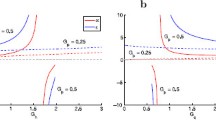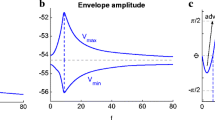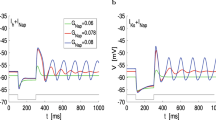Abstract
Subthreshold (membrane potential) resonance and phasonance (preferred amplitude and zero-phase responses to oscillatory inputs) in single neurons arise from the interaction between positive and negative feedback effects provided by relatively fast amplifying currents and slower resonant currents. In 2D neuronal systems, amplifying currents are required to be slave to voltage (instantaneously fast) for these phenomena to occur. In higher dimensional systems, additional currents operating at various effective time scales may modulate and annihilate existing resonances and generate antiresonance (minimum amplitude response) and antiphasonance (zero-phase response with phase monotonic properties opposite to phasonance). We use mathematical modeling, numerical simulations and dynamical systems tools to investigate the mechanisms underlying these phenomena in 3D linear models, which are obtained as the linearization of biophysical (conductance-based) models. We characterize the parameter regimes for which the system exhibits the various types of behavior mentioned above in the rather general case in which the underlying 2D system exhibits resonance. We consider two cases: (i) the interplay of two resonant gating variables, and (ii) the interplay of one resonant and one amplifying gating variables. Increasing levels of an amplifying current cause (i) a response amplification if the amplifying current is faster than the resonant current, (ii) resonance and phasonance attenuation and annihilation if the amplifying and resonant currents have identical dynamics, and (iii) antiresonance and antiphasonance if the amplifying current is slower than the resonant current. We investigate the underlying mechanisms by extending the envelope-plane diagram approach developed in previous work (for 2D systems) to three dimensions to include the additional gating variable, and constructing the corresponding envelope curves in these envelope-space diagrams. We find that antiresonance and antiphasonance emerge as the result of an asymptotic boundary layer problem in the frequency domain created by the different balances between the intrinsic time constants of the cell and the input frequency f as it changes. For large enough values of f the envelope curves are quasi-2D and the impedance profile decreases with the input frequency. In contrast, for f ≪ 1 the dynamics are quasi-1D and the impedance profile increases above the limiting value in the other regime. Antiresonance is created because the continuity of the solution requires the impedance profile to connect the portions belonging to the two regimes. If in doing so the phase profile crosses the zero value, then antiphasonance is also generated.

















Similar content being viewed by others
References
Beatty, J., Song, S.C., & Wilson, C.J. (2015). Cell-type-specific resonances shape the response of striatal neurons to synaptic inputs. Journal of Neurophysiology, 113, 688–700.
Boehlen, A., Heinemann, U., & Erchova, I. (2010). The range of intrinsic frequencies represented by medial entorhinal cortex stellate cells extends with age. The Journal of Neuroscience, 30, 4585–4589.
Boehlen, A., Henneberger, C., Heinemann, U., & Erchova, I. (2013). Contribution of near-threshold currents to intrinsic oscillatory activity in rat medial entorhinal cortex layer II stellate cells. The Journal of Physiology, 109, 445–463.
Chen, Y., Li, Rotstein, H.G., & Nadim, F. (2016). Membrane potential resonance frequency directly influences network frequency through gap junctions. Journal of Neurophysiology, 116, 1554–1563.
D’Angelo, E., Koekkoek, S.K.E., Lombardo, P., Solinas, S., Ros, E., Garrido, J., Schonewille, M., & De Zeeuw, C.I. (2009). Timing in the cerebellum: oscillations and resonance in the granular layer. Neuroscience, 162, 805–815.
Dorval, A.D. Jr., & White, J.A. (2005). Channel noise is essential for perithreshold oscillations in entorhinal stellate neurons. The Journal of Neuroscience, 25, 10025–10028.
Erchova, I., Kreck, G., Heinemann, U., & Herz, A.V.M. (2004). Dynamics of rat entorhinal cortex layer II and III cells: Characteristics of membrane potential resonance at rest predict oscillation properties near threshold. The Journal of Physiology, 560, 89–110.
Engel, T.A., Schimansky-Geier, L., Herz, A.V., Schreiber, S., & Erchova, I. (2008). Subthreshold membrane-potential resonances shape spike-train patterns in the entorhinal cortex. The Journal of Physiology, 100, 1576–1588.
Fox, D., Tseng, H., Rotstein, H.G., & Nadim, F. (2013). Membrane potential resonance of bursting neuron captured with an ICa/Ih biophysical model using multi-objective evolutionary algorithms. Society for Neuroscience Abstracts, 372.08, 79.
Fox, D.M., Tseng, H.-A., Rotstein, H.G., & Nadim, F. (2014). The role of a persistent inward current in shaping membrane resonance properties of different neuron types in an oscillatory network. Society for Neuroscience ? Abstracts, 215, 06.
Fox, D., Tseng, H., Rotstein, H.G., & Nadim, F. (2014). Using multi-objective evolutionary algorithms to predict the parameters that determine membrane resonance in a biophysical model of bursting neurons. BMC Neuroscience, 15, 79.
Fox, D.M., Rotstein, H.G., & Nadim, F. (2016). Neuromodulation produces complex changes in resonance profiles of neurons in an oscillatory network. Society for Neuroscience Abstracts, 811, 08.
Fox, D., Tseng, H., Smolinsky, T., Rotstein, H.G., & Nadim, F. (2017). Mechanisms of generation of membrane potential resonance in a neuron with multiple resonant ionic currents. PLoS Computational Biology. in press.
Gutfreund, Y., Yarom, Y., & Segev, I. (1995). Subthreshold oscillations and resonant frequency in Guinea pig cortical neurons: Physiology and modeling. The Journal of Physiology, 483, 621– 640.
Gastrein, P., Campanac, E., Gasselin, C., Cudmore, R.H., Bialowas, A., Carlier, E., Fronzaroli-Molinieres, L., Ankri, N., & Debanne, D. (2011). The role of hyperpolarization-activated cationic current in spike-time precision and intrinsic resonance in cortical neurons in vitro. The Journal of Physiology, 589, 3753–3773.
Haas, J.S., & White, J.A. (2002). Frequency selectivity of layer II stellate cells in the medial entorhinal cortex. The Journal of Physiology, 88, 2422–2429.
Heys, J.G., Giacomo, L.M., & Hasselmo, M.E. (2010). Cholinergic modulation of the resonance properties of stellate cells in layer II of the medial entorhinal. Journal of Neurophysiology, 104, 258–270.
Heys, J.G., Schultheiss, N.W., Shay, C.F., Tsuno, Y., & Hasselmo, M.E. (2012). Effects of acetylcholine on neuronal properties in entorhinal cortex. Frontiers in Behavioral Neuroscience, 6, 32.
Hodgkin, A.L., & Huxley, A.F. (1952). A quantitative description of membrane current and its application to conductance and excitation in nerve. The Journal of Physiology, 117, 500– 544.
Hutcheon, B., Miura, R.M., & Puil, E. (1996). Subthreshold membrane resonance in neocortical neurons. The Journal of Physiology, 76, 683–697.
Hutcheon, B., & Yarom, Y. (2000). Resonance, oscillations and the intrinsic frequency preferences in neurons. Trends in Neurosciences, 23, 216–222.
Hu, H., Vervaeke, K., & Storm, J.F. (2002). Two forms of electrical resonance at theta frequencies generated by M-current, h-current and persistent NA + current in rat hippocampal pyramidal cells. The Journal of Physiology, 545.3, 783–805.
Hu, H., Vervaeke, K., Graham, J.F., & Storm, L.J. (2009). Complementary theta resonance filtering by two spatially segregated mechanisms in CA1 hippocampal pyramidal neurons. The Journal of Neuroscience, 29, 14472–14483.
Kispersky, T., White, J.A., & Rotstein, H.G. (2010). The mechanism of abrupt transition between theta and hyperexcitable spiking activity in medial entorhinal cortex layer II stellate cells. PloS One, 5, e13697.
Lampl, I., & Yarom, Y. (1997). Subthreshold oscillations and resonant behaviour: Two manifestations of the same mechanism. Neuron, 78, 325–341.
Ledoux, E., & Brunel, N. (2011). Dynamics of networks of excitatory and inhibitory neurons in response to time-dependent inputs. Frontiers in Computational Neuroscience, 5, 1–17.
Leung, L.S., & Yu, H.W. (1998). Theta-frequency resonance in hippocampal CA1 neurons in vitro demonstrated by sinusoidal current injection. Journal of Neurophysiology, 79, 1592–1596.
Llinás, R.R., & Yarom, Y. (1986). Oscillatory properties of guinea pig olivary neurons and their pharmachological modulation: An in vitro study. The Journal of Physiology, 376, 163–182.
Marcelin, B., Becker, A., Migliore, M., Esclapez, M., & Bernard, C. (2009). H channel-dependent deficit of theta oscillation resonance and phase shift in temporal lobe epilepsy. Neurobiology of Disease, 33, 436–447.
Moca, V.V., Nicolic, D., Singer, W., & Muresan, R. (2014). Membrane resonance enables stable robust gamma oscillations. Cerebral Cortex, 24, 119–142.
Muresan, R., & Savin, C. (2007). Resonance or integration? self-sustained dynamics and excitability of neural microcircuits. Journal of Neurophysiology, 97, 1911–1930.
Narayanan, R., & Johnston, D. (2007). Long-term potentiation in rat hippocampal neurons is accompanied by spatially widespread changes in intrinsic oscillatory dynamics and excitability. Neuron, 56, 1061–1075.
Narayanan, R., & Johnston, D. (2008). The h channel mediates location dependence and plasticity of intrinsic phase response in rat hippocampal neurons. The Journal of Neuroscience, 28, 5846–5850.
Nolan, M.F., Dudman, J.T., Dodson, P.D., & Santoro, B. (2007). HCN1 Channels control resting and active integrative properties of stellate cells from layer II of the entorhinal cortex. The Journal of Neuroscience, 27, 12440–12551.
Pike, F.G., Goddard, R.S., Suckling, J.M., Ganter, P., Kasthuri, N., & Paulsen, O. (2000). Distinct frequency preferences of different types of rat hippocampal neurons in response to oscillatory input currents. The Journal of Physiology, 529, 205–213.
Prinz, A.A., Thirumalai, V., & Marder, E. (2003). The functional consequences of changes in the strength and duration of synaptic inputs to oscillatory neurons. The Journal of Neuroscience, 23, 943–954.
Rathour, R.K., & Narayanan, R. (2012). Inactivating ion channels augment robustness of subthreshold intrinsic response dynamics to parametric variability in hippocampal model neurons. The Journal of Physiology, 590, 5629–5652.
Rathour, R.K., & Narayanan, R. (2014). Homeostasis of functional maps in inactive dendrites emerges in the absence of individual channelostasis. Proceedings of the National Academy of Sciences of the United States of America, 111, E1787–E1796.
Richardson, M.J.E., Brunel, N., & Hakim, V. (2003). From subthreshold to firing-rate resonance. The Journal of Physiology, 89, 2538–2554.
Rotstein, H.G. (2013). Preferred frequency responses to oscillatory inputs in an electrochemical cell model: Linear amplitude and phase resonance. Physical Review E, 88, 062913.
Rotstein, H.G. (2014). Frequency preference response to oscillatory inputs in two-dimensional neural models: a geometric approach to subthreshold amplitude and phase resonance. The Journal of Mathematical Neuroscience, 4, 11.
Rotstein, H.G., & Nadim, F. (2014). Frequency preference in two-dimensional neural models: a linear analysis of the interaction between resonant and amplifying current. Journal of Computational Neuroscience, 37, 9–28.
Rotstein, H.G. (2015). Subthreshold amplitude and phase resonance in models of quadratic type: nonlinear effects generated by the interplay of resonant and amplifying currents. Journal of Computational Neuroscience, 38, 325–354.
Rotstein, H.G. (2016). The shaping of intrinsic membrane potential oscillations: positive/negative feedback, ionic resonance/amplification, nonlinearities and time scales. Journal of Computational Neuroscience (2017), 42, 133–166.
Schreiber, S., Erchova, I., Heinemann, U., & Herz, A.V. (2004). Subthreshold resonance explains the frequency-dependent integration of periodic as well as random stimuli in the entorhinal cortex. The Journal of Physiology, 92, 408–415.
Schmidt, S.L., Dorsett, C.R., Iyengar, A.K., & Frölich, F. (2016). Interaction of intrinsic and synaptic currents mediate network resonance driven by layer V pyramidal cells Cereb. Cortex, page. doi:10.1093/cercor/bhw242.
Sharp, A.A., O’Neil, M.B., Abbott, L.F., & Marder, E. (1993). The dynamic clamp: artificial conductances in biological neurons. Trends in Neurosciences, 16, 389–394.
Skinner, F.K. (2006). Conductance-based models. Scholarpedia, 1, 1408.
Song, S.C., Beatty, J.A., & Wilson, C.J. (2016). The ionic mechanism of membrane potential oscillations and membrane resonance in striatal lts interneurons. Journal of Neurophysiology, 116, 1752–1764.
Solinas, S., Forti, L., Cesana, E., Mapelli, J., De Schutter, E., & nAngelo, E. (2007). Fast-reset of pacemaking and theta-frequency resonance in cerebellar Golgi cells: simulations of their impact in vivo. Frontiers in Cellular Neuroscience, 1, 4.
Stark, E., Eichler, R., Roux, L., Fujisawa, S., Rotstein, H.G., & Buzsáki, G. (2013). Inhibition-induced theta resonance in cortical circuits. Neuron, 80, 1263–1276.
Tikidji-Hamburyan, R.A., Martínez, J.J., White, J.A., & Canavier, C. (2015). Resonant interneurons can increase robustness of gamma oscillations. The Journal of Neuroscience, 35, 15682–15695.
Tohidi, V., & Nadim, F. (2009). Membrane resonance in bursting pacemaker neurons of an oscillatory network is correlated with network frequency. The Journal of Neuroscience, 6427, 6435.
Tseng, H., & Nadim, F. (2010). The membrane potential waveform on bursting pacemaker neurons is a predictor of their preferred frequency and the network cycle frequency. The Journal of Neuroscience, 30, 10809–10819.
Wu, N., Hsiao, C.-F., & Chandler, S.H. (2001). Membrane resonance and subthreshold membrane oscillations in mesencephalic V neurons: Participants in burst generation. The Journal of Neuroscience, 21, 3729–3739.
Zemankovics, R., Káli, S., Paulsen, O., Freund, T.F., & Hájos, N. (2010). Differences in subthershold resonance of hippocampal pyramidal cells and interneurons: The role of h-current and passive membrane characteristics. The Journal of Physiology, 588, 2109–2132.
Acknowledgements
This work was supported by the NSF grants DMS-1313861 and DMS-1608077 (HGR).
Author information
Authors and Affiliations
Corresponding author
Ethics declarations
Conflict of interests
The author declares that he has no conflict of interest.
Additional information
Action Editor: Nicolas Brunel
Appendices
Appendix
A Impedance and phase profiles for 2D and 3D linear systems: Analytic expressions
In order to analytically compute he impedance and phase profiles for 3D linear generic systems we use
where a, b, c, α, β, p and q are constant, ω > 0 and A i n ≥ 0.
The characteristic polynomial for the corresponding homogeneous system (A i n = 0) is given by
The particular solution to system (44) has the form
Substituting (46) into system (44), rearranging terms, and solving the resulting algebraic system one obtains
where
and
From Eq. (47)
and
For a 2D linear system (c = q = 0), the characteristic polynomial for the corresponding homogeneous system (A i n = 0) is given by
The roots of the characteristic polynomial are given by
From Eq. (55), the homogeneous (unforced) system displays oscillatory solutions with a natural frequency f n a t (Hz) given by
provided 4 b α + (a − p)2 < 0.
The impedance amplitude and phase are given, respectively, by
and
Rights and permissions
About this article
Cite this article
Rotstein, H.G. Resonance modulation, annihilation and generation of anti-resonance and anti-phasonance in 3D neuronal systems: interplay of resonant and amplifying currents with slow dynamics. J Comput Neurosci 43, 35–63 (2017). https://doi.org/10.1007/s10827-017-0646-8
Received:
Revised:
Accepted:
Published:
Issue Date:
DOI: https://doi.org/10.1007/s10827-017-0646-8




